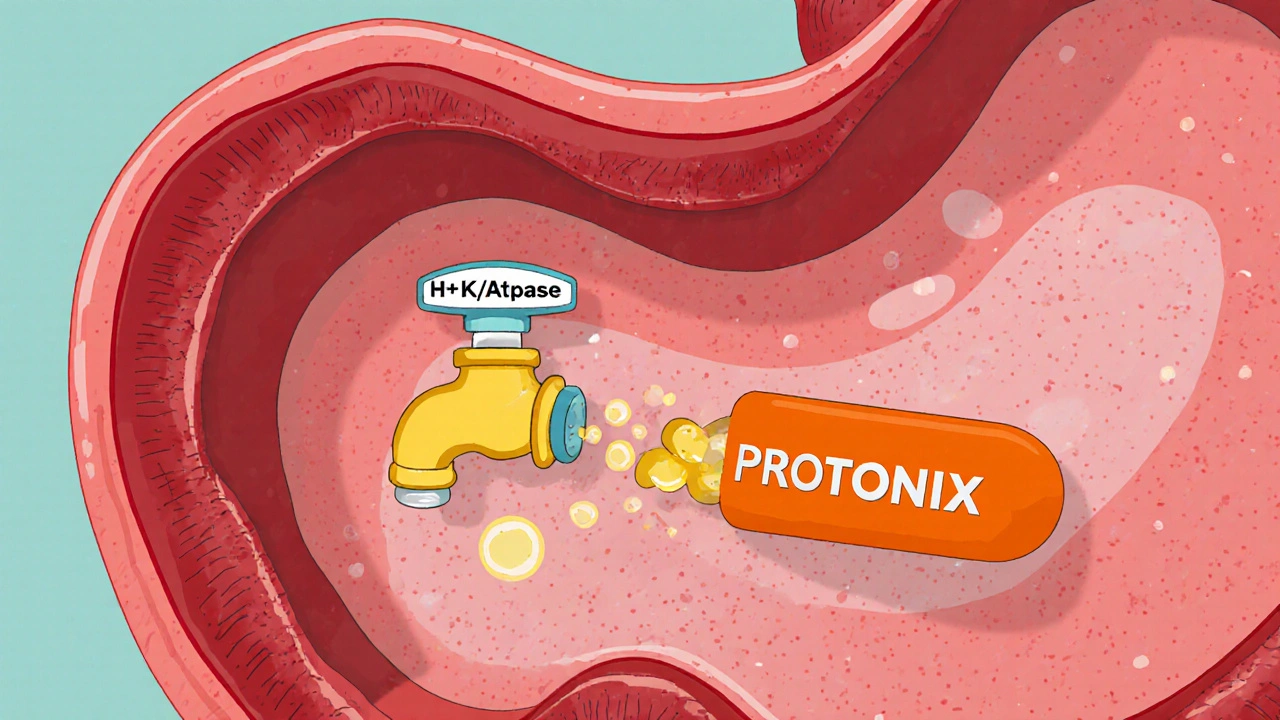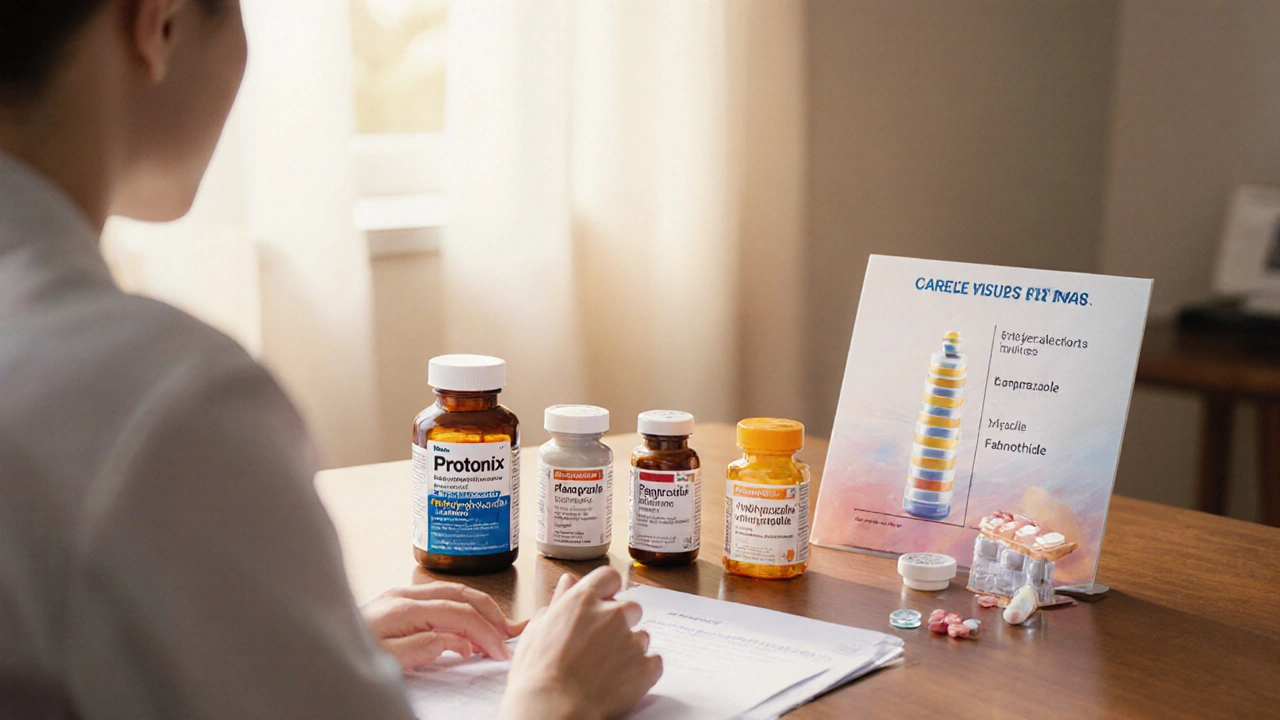Protonix vs Other Acid-Reducer Pills Comparison Tool
Recommended Acid Reducer:
Please select your criteria and click 'Find Best Acid Reducer Match' to get personalized recommendations.
Key Takeaways
- Protonix (pantoprazole) is a strong, once‑daily PPI best for moderate‑to‑severe GERD.
- Common alternatives include omeprazole, esomeprazole, lansoprazole, rabeprazole, and the H2 blocker famotidine.
- Most PPIs have similar efficacy; differences lie in onset speed, drug interactions, and cost.
- In Australia, generic PPIs are often cheaper than brand‑name Protonix, but insurance coverage can vary.
- Switching drugs should be done with a doctor’s guidance to avoid rebound acid hypersecretion.
Trying to decide whether Protonix is the right choice can feel like walking through a pharmacy aisle blindfolded. You know it treats acid‑related problems, but dozens of other pills claim to do the same thing. This guide cuts through the jargon, compares the most popular alternatives, and helps you figure out which acid‑reducer matches your lifestyle, budget, and health needs.
Protonix (Pantoprazole) is a prescription proton pump inhibitor (PPI) that reduces stomach acid production. It works by blocking the H+/K+ ATPase enzyme-the “final faucet” that pours acid into the stomach. By shutting that faucet, Protonix can relieve heartburn, heal esophageal lining damage, and prevent ulcer recurrence.
How Protonix Works and When It’s Used
Protonix binds irreversibly to the proton pump in parietal cells, cutting acid output by up to 95% after a few days of consistent dosing. Doctors usually prescribe it for:
- Gastro‑esophageal reflux disease (GERD) that doesn’t improve with lifestyle changes.
- Erosive esophagitis confirmed by endoscopy.
- Prevention of NSAID‑induced ulcers.
- Zollinger‑Ellison syndrome (a rare condition with excess stomach acid).
The typical adult dose is 40mg once daily, taken before a meal. For severe cases, a doctor may increase to 80mg or split the dose into twice‑daily administrations.
Side Effects and Safety Concerns
Most people tolerate Protonix well, but you might notice:
- Headache or mild dizziness.
- Diarrhoea or constipation (usually settles after a week).
- Lowered magnesium or vitamin B12 levels with long‑term use.
Rare but serious risks include kidney problems, Clostridioides difficile infection, and bone fracture risk if you stay on PPIs for years. Because of these concerns, doctors often limit continuous use to eight‑to‑twelve weeks unless there’s a compelling reason to continue.

Popular Alternatives to Protonix
If you’re looking for a cheaper option, a different dosing schedule, or a drug with fewer interactions, the market offers several competitors. Below is a quick snapshot of each.
Omeprazole is a generic PPI commonly sold under brand names like Prilosec. It’s the oldest PPI on the market and works similarly to pantoprazole, but it reaches peak levels slightly faster.
Esomeprazole (Nexium) is the S‑isomer of omeprazole, marketed as a “stronger” version with a marginally longer half‑life.
Lansoprazole (Prevacid) offers a once‑daily dose that can be taken with or without food, which some patients find convenient.
Rabeprazole (AcipHex) is known for a rapid onset-often within an hour-making it a good choice for night‑time heartburn.
Famotidine (Pepcid) is an H2‑receptor antagonist, not a PPI. It reduces acid production less dramatically but works quickly and can be combined with a low‑dose PPI if needed.
Calcium carbonate (Tums) is an over‑the‑counter antacid that neutralises existing stomach acid rather than preventing its production.
Side‑by‑Side Comparison
| Drug | Class | Typical Dose | Onset | Half‑life | Common Side Effects | Approx. Cost (AU$/month) |
|---|---|---|---|---|---|---|
| Protonix (Pantoprazole) | PPI | 40mg once daily | 1-2h | 1h (active metabolite 2h) | Headache, diarrhoea, magnesium loss | ≈$30-$45 (brand) / $12-$18 (generic) |
| Omeprazole | PPI | 20-40mg daily | 0.5-1h | 1h | Upper‑respiratory infection, nausea | ≈$10-$20 (generic) |
| Esomeprazole | PPI | 20-40mg daily | 1h | 1-1.5h | Abdominal pain, flatulence | ≈$25-$35 (brand) / $15-$22 (generic) |
| Lansoprazole | PPI | 15-30mg daily | 1-2h | 1.5h | Dizziness, skin rash | ≈$12-$20 (generic) |
| Rabeprazole | PPI | 20mg daily | ≈1h (fastest among PPIs) | 1h | Dry mouth, constipation | ≈$15-$25 (generic) |
| Famotidine | H2‑blocker | 20-40mg daily | 30min-1h | 2-3h | Headache, fatigue | ≈$5-$12 (generic) |
| Calcium carbonate | Antacid | 500mg-1g as needed | Immediate | Not applicable | Constipation or “acid‑rebounds” | ≈$2-$5 (OTC) |
Choosing the Right Pill for Your Situation
Here’s a quick decision flow you can run through with your doctor:
- If you need potent, long‑lasting acid suppression and have moderate‑to‑severe GERD, Protonix or another PPI is the first‑line choice.
- If cost is the biggest barrier and you have mild‑to‑moderate symptoms, omeprazole or lansoprazole (both widely available as generics) often deliver the same relief.
- For night‑time heartburn that spikes quickly, rabeprazole’s fast onset may be preferable.
- If you’re worried about long‑term PPI risks, consider a step‑down strategy: start with a PPI, then transition to famotidine or occasional antacids once symptoms improve.
- When you have drug‑interaction concerns (e.g., clopidogrel, certain HIV meds), ask about pantoprazole’s lower CYP‑enzyme impact compared with omeprazole.
Remember, no medication should replace lifestyle tweaks-weight management, avoiding late‑night meals, and limiting caffeine and alcohol often cut the need for a daily pill.

Cost, Insurance, and Availability in Australia
Pharmaceutical Benefit Scheme (PBS) listings affect how much you pay out‑of‑pocket. As of 2025, generic pantoprazole is not listed, so you’ll pay the full price unless you have private health cover. Omeprazole and lansoprazole are PBS‑eligible, dropping the cost to about $5 per month for most eligible patients.
If you have a private prescription, ask your pharmacist for the cheapest generic brand. Some chain pharmacies run discount programs that bring a 40mg pantoprazole pack to under $10.
Switching Between Acid‑Reducers Safely
Never stop a PPI abruptly if you’ve been on it for more than a few weeks-your stomach may over‑produce acid, leading to rebound heartburn. A typical taper looks like:
- Continue your current dose for two weeks.
- Reduce to half the dose (e.g., 20mg pantoprazole) for another two weeks.
- Switch to an H2‑blocker like famotidine for a month.
- Move to occasional antacids if needed.
Always discuss the plan with your clinician, especially if you have ulcer disease or take NSAIDs.
Frequently Asked Questions
Is Protonix stronger than other PPIs?
Strength is relative. All PPIs inhibit the proton pump to a similar degree when taken at the recommended dose. Differences arise in how quickly they act, how they interact with other drugs, and their cost. Pantoprazole (Protonix) has a slightly lower risk of affecting the CYP‑450 enzyme system, which can be a benefit for patients on multiple meds.
Can I use an over‑the‑counter antacid instead of Protonix?
Antacids like calcium carbonate neutralise acid that’s already in the stomach, providing quick relief for mild symptoms. They don’t prevent acid from being produced, so they aren’t effective for chronic GERD, erosive esophagitis, or ulcer prevention. For those conditions, a PPI such as Protonix is usually required.
What are the biggest side‑effects to watch for on long‑term PPI use?
Long‑term use (over six months) can lower magnesium and vitamin B12 levels, increase the risk of bone fractures, and predispose you to gut infections like C. difficile. Regular blood tests and supplementing magnesium or B12, if needed, can mitigate these risks.
Is it safe to take Protonix with blood thinners?
Protonix has minimal interaction with warfarin or newer anticoagulants compared with omeprazole, which can increase INR levels. However, always inform your prescriber; they may advise periodic clotting tests when starting any new medication.
How quickly will I feel relief after the first dose?
Most PPIs, including Protonix, start reducing acid within 1-2hours, but maximal healing of the esophagus can take 2-4 weeks. If you need immediate relief, combine a PPI with a fast‑acting antacid for the first few days.
Next Steps
Grab a pen, list your current symptoms, any other medicines you take, and your budget. Bring that list to your GP or pharmacist and ask which of the drugs in the table fits best. If you’re already on Protonix and wonder whether to switch, discuss a taper plan to avoid rebound acid. Finally, keep track of how you feel for a couple of weeks-this real‑world feedback will tell you if you made the right choice.


Paul Griffin
October 7, 2025 AT 17:30When considering a switch to Protonix, it is prudent to schedule a consultation with your primary care physician or gastroenterologist, ensuring that your medical history and current medication regimen are thoroughly reviewed before making any changes.
Michael Tekely
October 16, 2025 AT 23:43Got it, the key is aligning drug‑interaction profiles while leveraging pharmacokinetic advantages for optimal symptom relief.
Oscar Taveras
October 26, 2025 AT 05:56Excellent point, staying informed empowers you to choose the most suitable therapy for your condition :)
katie clark
November 4, 2025 AT 12:10One must appreciate the nuanced pharmacodynamic distinctions that delineate pantoprazole from its contemporaries.
Carissa Engle
November 13, 2025 AT 18:23It is indispensable to acknowledge that while proton pump inhibitors share a common mechanistic endpoint of gastric acid suppression the pharmacokinetic parameters such as absorption latency bioavailability variance and metabolic pathways diverge markedly especially when one scrutinizes the cytochrome P450 isozyme affinity and the resultant drug‑drug interaction potential the clinical implications of these variances become evident particularly in polypharmacy contexts wherein a patient is concurrently administered antiplatelet agents anticoagulants immunosuppressants or antiviral regimens thus necessitating a judicious selection of the acid reducer the literature further elucidates that long‑term utilization of high potency PPIs is associated with perturbations in mineral homeostasis notably magnesium and calcium deficiencies which may precipitate osteoporotic sequelae consequently periodic laboratory monitoring is advocated alongside supplementation strategies when indicated moreover the rebound hypersecretion phenomenon observed upon abrupt cessation of PPIs underscores the need for a tapered discontinuation protocol the financial burden imposed by brand name formulations cannot be ignored as generic equivalents often provide comparable efficacy at a fraction of the cost the health economics perspective therefore favors a cost‑effectiveness analysis prior to committing to a branded therapeutic course the safety profile of pantoprazole, for instance, is characterized by a relatively modest impact on CYP‑mediated metabolism which may confer an advantage in patients with intricate medication schedules the overarching principle remains that individualized therapy, guided by a comprehensive assessment of symptom severity comorbidities pharmacogenomics and socioeconomic factors, optimizes clinical outcomes while mitigating adverse events.
Dervla Rooney
November 23, 2025 AT 00:36I hear your concerns and appreciate the depth of the analysis; it might be helpful to also consider a gradual taper plan if you’ve been on a PPI for an extended period, as this can reduce rebound acidity and make the transition smoother.
Johnny Ha
December 2, 2025 AT 06:50People don’t realize the pharma giants push these pricey pills to keep us hooked while the real cure is diet and lifestyle, so question everything the system tells you.